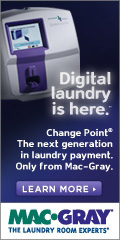
| Past Issues | Advertise | www.faahq.org | Multifamily FLORIDA archive | February 2013 |
Attention Kmart Shoppers: Visit Aisle 42 for Water Bills at 30 Percent Off
When Saturday Night Live makes fun of you, you have hit the big time.
Do you remember the old days when Kmart was the 900-pound gorilla of retail?
Everyone was familiar with its Blue Light
Special, in which a mobile blue light was quietly placed somewhere in the
store where an item was about to be discounted. Then came the world famous
announcement:
Attention
Kmart shoppers! Fruit of the Loom athletic socks are on sale in aisle 28!
The Blue Light Special was not
just any cultural icon. It was a Hollywood star. Saturday Night Live did skits
every week portraying Kmart shoppers as rabid animals trained to salivate upon
hearing the words – Attention Kmart
Shoppers.
Then something happened. The blue light that once glowed so brightly is
now but a mere dim bulb. What happened to Kmart? Many would say that Walmart
happened to Kmart, but that is only part of the story.
Just like everyone in the multihousing industry has always been
concerned with minimizing vacancy rates and utility expenses, everyone in
retail has always been focused on inventory control. Kmart was as worried as
Walmart about ordering too many chocolate Easter bunnies in February or not
enough winter coats for the cold season. Though there were a number of
differences between these two competitors, the stark contrast between Walmart’s
success and Kmart’s failure was largely attributable to how each company used
technology to further efficiency and execution.
Technology happened FOR Walmart.
Technology happened TO Kmart.
Walmart didn’t invent any new technology. It didn’t have to. The founder – Sam Walton – made use of already existing technology. With the help of technology, Walmart knew exactly how many Oster 6-cup blenders were on the shelves in a given moment and how many raincoat accessories for Barbie Dolls were stored in a given distribution center. Walmart’s efficiency enabled it to offer lower prices to customers. Kmart, figuratively speaking, was busy trying to recoup money lost on spoiled chocolate Easter bunnies. Such as it was, Kmart survived only after filing Chapter 11 in 2002. Multihousing properties that recoup water costs from tenants are more
efficient. Studies show that residents of submetered apartments consume 16 percent to
39 percent less water than in cases where unlimited water is offered free with rent.
Properties that employ RUBS (Ration Utility Billing) use 6 percent to 27 percent less water.*
How does efficiency benefit the property owner?
Take for example:
1.
The property owner nets $90 more per unit per month than
last year rather than only $70 more.
2.
The resident spends only $68 more per month than if there
had been a $70 rent increase.
Efficiency makes more money for the owner while empowering residents to save money via conservation. Speaking of efficiency, whether you decide to use submeters or RUBS, it
needs to execute in an efficient manner. You don’t want to be like K-Mart –
filling dumpsters with chocolate Easter bunnies on the Monday after Easter.
Before you hire a third party billing Company to provide submetering or RUBS
for your property, here’s some questions to ask:
In the case of submeters, here are some additional questions to ask the
third party billing Company:
Here are a few questions to ask yourself:
Of course, you need to ask the relevant cost questions:
Submetering has come a long way since the late 1980’s when only a few US
multihousing owners began employing the technology. The technology works. The
capabilities are robust. Because Florida’s water rates are expensive and
continuing to increase, it is important to be efficient.
Water costs can happen TO you. Or water billing can happen FOR you. * For a comparison of results from five studies, see page 178 of http://www.nmhc.org/files/ContentFiles/General/full_final.pdf For RUBS results, see page 3 from http://www.nmhc.org/files/ContentFiles/FinalLegReg/Water%20Comments.pdf ** NTEP – National Type Evaluation Program is administered
by National Conference on Weights and Measures.
Article Contributed by PSC Member: Steve Hirsch
|


